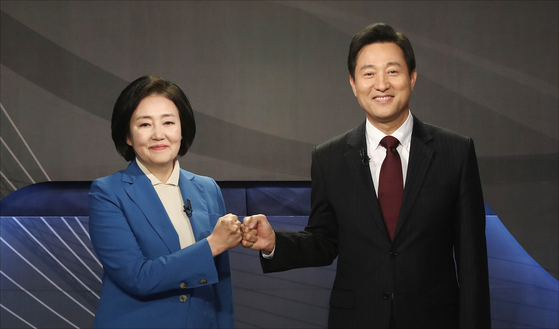
Democratic Party Mayor Park Young-seon (left) and Seoul Mayor Oh Se-hoon, Mayor of the People’s Power, are facing each other before the start of a debate on candidates for the Seoul Mayor’s by-election by the Korean Broadcasting Journalists Club at the Ye General Hall in Yangcheon-gu, Seoul on the afternoon of the 5th. Reporter Oh Jong-taek
On the 6th, the day before the main vote of the Seoul Mayor’s by-election, the opposition parties were busy calculating votes. What each camp looked at most keenly was the turnout. This is because opinion polls are only an estimate, and how much supporters are actually drawn to the polling place determines the joy of the election.
The pre-election rate for re-election this time was 20.5%, the highest value ever for re-election. In particular, the preliminary turnout in Seoul was 21.9%, an increase of 2.8 percentage points from the election of the mayor of Seoul three years ago. However, since the 7th election is held on weekdays, a cautious response came out from each camp, saying, “It is difficult to judge the turnout rate.”
Democratic Party “If 70% of the supporters come out at the polling place, they will win back.

Candidate Park Young-sun, Mayor of the Democratic Party of Seoul, appeals for support at the Gwanghwamun intensive campaign held in front of Dongwha Duty Free in Jongno-gu, Seoul on the 6th. Reporter Oh Jong-taek
Park Young-seon, who predicts that the final turnout will be around 50%, and the Democratic Party Mayor of Seoul, analyze that such a turnout is not at all disadvantageous. Jin Seong-joon, head of Strategic Planning Headquarters at Candidate Park’s camp, spoke with the JoongAng Ilbo on that day. “There is a gathering of supporters who were not caught in the polls,” he said.
In the party, there is also an analysis that “if only 70% of the supporters appear at the polling place, it is possible to win in reverse.” The basis is the total number of votes the Democratic Party won in Seoul at last year’s general election of 3.05 million. The number of voters in Seoul this time is 8.42 million, and when the turnout is 50%, the total number of votes is 4.21 million. The Democratic Party’s calculation is that 70% of the 3,500,000 votes obtained in the general election last year will be able to win if they choose the Democratic Party again. A key official of the Democratic Party’s predecessor said, “I don’t know if the vote is 70%, or if it’s 50%, it’s worth trying.”
The Democratic Party is also looking forward to the organization tax in Seoul. An official from the Democratic Party said, “Seoul has a strong comparative advantage in the network of not only party organizations, but also civic groups and professional organizations.” Democratic Party Standing Chairman Lee Nak-yeon appeared on CBS radio this morning and claimed, “We have predicted a round-trip game of around 3% from a long time ago.” “Our supporters, who did not speak, began to speak.”
The power of the people “50% of the vote is glass, and 55% of the vote will harden the victory”

Mayor Oh Se-hoon, the power of the people, is running a campaign at the intersection in front of Sanggye Paik Hospital in Nowon-gu, Seoul on the morning of the 6th. Reporter Oh Jong-taek
On the other hand, the power of the people is holding the ‘50% vote rate’ as the baseline for candidate Oh Se-hoon to win. An official at Candidate Camp Oh said, “If the vote exceeds 50%, it is advantageous, and if it exceeds 55%, it is expected that the victory will be firmly established.”
The reason why the people’s power set 50% of the turnout as a baseline is that the ruling party’s organizational power can be overcome with public opinion if a majority of the voters vote. The political opinion is that the democratic party’s organizational power, which occupies 101 out of 109 members of the Seoul City Council and 24 out of 25 mayor of the Seoul district, outperforms the power of the people, because the lower the turnout, the more powerful this grassroots organizational power is.
It was also judged that a high voter turnout would have the effect of a strong vote of the previous candidate in the polls. Candidate Oh said in an interview with the JoongAng Ilbo on the 4th, “I think my approval rating will be maintained, but in the end, the election is a fight at the polling place, so there is always anxiety.” An official from the power of the people said, “Even if the voter vote is high, the vote is lost that much,” and said, “We are holding the concept of last minute campaign to encourage voting in this election.”
Candidate Oh also believes that the turnout will be influenced by those in their 20s who turned their backs on the government and the ruling party. A key official of Candidate Oh said, “If angry twenties find the actual polling place, the turnout will rise sharply than in the past,” he added. “However, unlike generations in their 60s and above, it is a variable that the turnout of young people is usually low.”
Reporter Oh Hyun-seok and Son Kook-hee [email protected]
![]()
